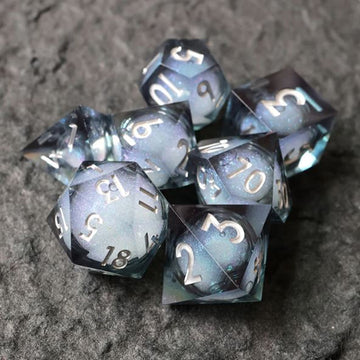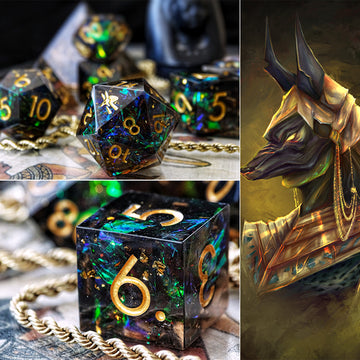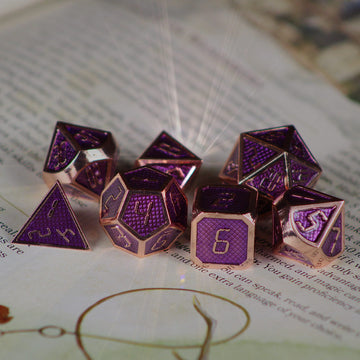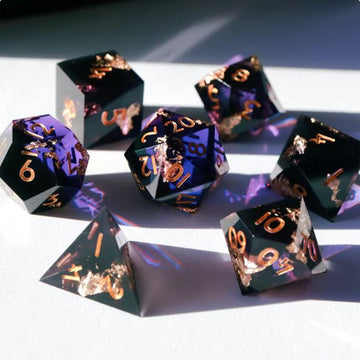Hacking the sorcerer is both possible and fun. With this handy guide, you can take your humble sorcerer and cut a path through a campaign leaving doom, death, and destruction in your wake!
I’ll go over the best ways to begin building your sorcerer and offer suggestions on multiclassing and feats. However, you’ll want to keep one important detail in mind: the sorcerer is a very squishy class with only 1d6 health dice per level. If playing a squishy spellcaster is right up your alley, grab some sorcerer dice, print out a character sheet, and let’s begin.
The sorcerer is the perfect balance between a wizard and a warlock, meaning that hacking them gains the benefits of both. In fact, sorcerers share many spells with wizards, but they have more spell slots than warlocks. As a bonus, the sorcerer is the only class that can twist their spells to fit specific situations.
Table of Contents
- Building Your Sorcerer
- Multi-classing and Feats
- Subclasses
Of course, remember that these are suggestions and not absolute rules. You should play what makes you happy, even if you want to maximize your sorcerer. Now, let’s get started!
Building Your Sorcerer
No one can learn how to be a sorcerer. Instead, their magic comes from their bloodline, some strange event, or has always been inside of them waiting for the right moment to manifest. Such an interesting class has some unique advantages, but you’ll need to properly set up and understand the sorcerer before you can fully utilize them.
Stats
As I mentioned before, the sorcerer has a very low hit dice, so a good Constitution and Dexterity score can be the difference between life and death. However, the highest score should be your Charisma. This is your spellcasting modifier and it is what makes the sorcerer a perfect face for the party.
If you want to do a point buy, consider this layout: Str 8, Dex 14, Con 14, Int 10, Wis 10, and Cha 15. This is a good starting point for any level 1 sorcerer and it gives you plenty of room to use the first few level ups to raise your stats.
Spells
When it comes to spells, the sorcerer is like the bard: you have a certain number of spells that you know and you can replace one spell per level up. This limitation means that you need to know when and how to cast your low level spells using higher level spell slots. This is where the sorcerer’s metamagic comes in.
Metamagic allows a sorcerer to twist spells to fit their needs, allowing them to capitalize on the limited number of spells they know. However, not all metamagic abilities are equal. Each one has their place, so let’s look at the top three options.
First, Heightened Spell is a fantastic choice to use on spells that require a saving throw. This option costs 3 sorcery points to force disadvantage on the first saving throw made against the spell. However, keep in mind that some spells like Hold Person have repeated saving throws, making the Heightened Spell option better suited for spells that only have one save.
Similarly, Quickened Spell costs 2 sorcery points and it allows you to cast a regular spell plus a cantrip in one turn. With this in mind, do not be tempted to constantly use this option. It will eat through your sorcery points, so use it when it is needed the most.
Finally, the Twinned Spell option allows you to target two creatures with a spell that usually targets only one, such as Haste and Chromatic Orb. The downside is that the cost increases with the spell’s level (starting at 1 point if it’s a cantrip). This is a very expensive option, but can be incredibly helpful if you know when and where to use it.
Altogether, the sorcerer spell list is filled with powerful spells that can be used to fix any situation if you use them right. The trick to using these spells with metamagic is keeping track of your points and being both cautious and creative with your spell use. While spells are fantastic, there are more benefits at the sorcerer’s disposal.
Multiclassing and Feats
The sorcerer is a powerful class, but there are ways you can gain a few more advantages with them. I’ll discuss some of the best multiclassing and feat options to help maximize your sorcerer’s power.
Multiclassing
Most DM’s will have different rules about multiclassing and those rules are vital for you to know, especially for the sorcerer. Multiclassing can grant your sorcerer a higher AC and even some new spells otherwise unavailable to you. While you sacrifice gaining higher level sorcerer spells, you gain enough to make it worth it.
If you want to pick the best option for multiclassing, the artificer will provide some major benefits to your sorcerer. You’ll gain proficiency in medium armor and shields, while also having access to spells sorcerers don’t get such as Cure Wounds and Alarm. Similarly, artificers round up when determining their spell slots and they are ritual casters, something that sorcerers don’t have.
On the other hand, multiclassing into warlock offers many benefits, such as the powerful Eldritch Blast. You’ll also gain proficiency with medium armor and shields, and you will be able to use your Charisma modifier when attacking with a weapon. One of the best benefits is the fact that warlock spell slots recharge on a short rest, which make these slots great fodder for more sorcery points.
The bard, however, is another great option. Bards are full casters, so you won’t lose any spell slots when leveling up. You’ll also gain the benefits of the bard’s Jack of All Trades and Song of Rest at level 2 and then Expertise at level 3, which can help tilt your sorcerer’s abilities from good to excellent.
While multiclassing offers benefits, I strongly suggest not leveling up too far in any second class you take. Each level up will stall you getting higher level sorcerer spells. Instead, focus a multiclassing max of level 2 or 3, and continue to consistently level up in sorcerer.
Feats
The next boost for sorcerers that needs to be addressed is to think about what feats are good for them. The short answer is: most feats are good feats. The better answer is: some feats are much better suited to the sorcerer than others.
For example, the Elemental Adept feat offers great benefits to elemental damage types. However, this feat is only helpful if your sorcerer is from the Draconic Bloodline, which places a large focus on one elemental type. For all other sorcerers, this feat serves very little purpose and could be considered a waste.
On the other hand, the Inspiring Leader feat takes advantage of the sorcerer’s high Charisma by granting temporary hit points for up to six creatures of your choice. This option is fantastic if your party lacks a dedicated healer.
However, the Spell Sniper feat must also be considered, especially for sorcerers that will not be multiclassing into warlock. You can use this feat to snipe Eldritch Blast while also increasing the range of your attack-based spells and allowing your spells to ignore half and three-quarters cover.
Keep in mind that feats take away from ability score improvements and you only get such options at levels 4, 8, 12, 16, and 19. If you multiclass, it can take longer to reach these levels, so think carefully about which feats you want to take.
Subclasses
Finally, the sorcerous origins subclass will decide the exact power your sorcerer will possess. I’ll cover the best three that offer something unique to your sorcerer, but remember to play what is fun and interesting for you. Now, without further ado, the three top sorcerer subclasses.
The Draconic Bloodline: The Dragon
Sorcerers from the Draconic Bloodline (Player’s Handbook) origin share blood with a draconic ancestry or made a deal with a dragon. Every sorcerer from this origin chooses a type of dragon, granting them that dragon’s damage type.
When choosing your dragon type, consider taking any of the dragons that deal fire damage (Brass, Gold, and Red dragons). There are more fire-damage spells than any other element, and while a lot of creatures have fire-resistance, the Elemental Adept feat can negate that resistance and allow you to deal massive damage through fire-spells such as Fireball and Fire Bolt. Not to mention that, at 6th level, you add your Charisma modifier to any spell you cast that deals damage with your associated element.
Another major benefit of this origin is the Draconic Resilience you gain at 1st level. This makes your hit point maximum increase by 1 whenever you gain a level in sorcerer. Likewise, you gain patches of scales and, when you are not wearing armor, your AC equals 13 + your Dexterity modifier.
Of course, the fun begins at 14th level, thanks to your draconic ancestry. You will be able to sprout wings as a bonus action on your turn and gain a flying speed equal to your current speed. However you cannot manifest these wings while wearing armor unless your armor accommodates them.
Overall, the Draconic Bloodline is a sorcerer classic and deals great damage output from any chosen element, especially if your sorcerer takes the Elemental Adept feat. Plus, with the ability to fly at higher levels, you’ll be able to rain down terror from above! You can become the dragon you have always wanted to be with just a few level-ups!
The Divine Soul: Master of Divine and Arcane Magics
Can’t choose between a cleric or a sorcerer? Have no fear, the Divine Soul (Xanathar’s Guide to Everything) is here! This origin comes from a divine source, such as a blood connection to an angel or being born as part of some divine prophecy.
No matter the source of the origin, the Divine Soul has the ability to learn cleric spells, granting you some of the best healing spells in the game such as Cure Wounds and Healing Word. Likewise, this origin allows you to choose the affinity of your divine power. I suggest taking Law as it automatically gives you the spell Bless, which is great at any level.
However, one of the most powerful parts of this origin is being Favored By The Gods. At 1st level, the divine powers protect your destiny, allowing you to roll 2d4 and add it to a failed attack roll or saving throw, potentially changing your fate. This feature can only be used once per short or long rest, but the potential to alter your luck can come in handy.
This origin also strengthens healing spells through Empowered Healing at 6th level. This means when you (or an ally within 5 feet of you) rolls for the number of hit points they gain, you can spend 1 sorcery point to reroll any of the dice once. While you can only use this once per turn, as long as you are not incapacitated, you can potentially save a life!
Finally, you can become an angel with Otherworldly Wings at 14th level. Just like with the Draconic Bloodline, these wings are activated and dismissed as a bonus action, except they have a set flying speed of 30 feet and are not affected by any armor. They also change appearance based on your affinity, such as Law having eagle wings.
For the most part, the Divine Soul origin can make your sorcerer the dedicated party healer with extra benefits. Although, if you multiclass into Warlock or snag the Spell Sniper feat, you can rain down holy anger through Eldritch Blast while flying over the enemy’s head. What’s not to love?
Shadow Magic: The Tactician
Now, if you prefer to hold special advantages over your opponents in battle, then the Shadow Magic origin will be perfect for you. With this origin, your sorcerer’s magic comes from the Shadowfell and your soul is embedded in darkness—although that’s not necessarily a bad thing. This origin allows you to pick or roll for an origin quirk, such as having icy cold skin or not seeming to breathe when you sleep.
In addition to being fun to play, this origin offers several incredible benefits. First, Eyes of the Dark, which grants you darkvision up to 120 feet. You’ll also be able to learn Darkness at 3rd level and you can cast it using 2 sorcery points or a spell slot, but if you cast it through sorcery points, you can see through that darkness.
Let’s not forget the Strength of the Grave, which allows you to make a Charisma saving throw on an attack that puts you at 0 hit points. If you succeed, you drop to 1 hit point instead. However, you cannot use this skill if you were hit with a radiant attack or a critical hit and you can only use it once per long rest.
At 6th level, you’ll gain the Hound of Ill Omen which lets you summon a creature of darkness to harass your enemies. The hound automatically knows where its target is located, so if your enemy decides to cast Invisibility, they cannot hide from your loyal beast.
Finally, at 14th level, you gain the ability Shadow Walk. This allows you to step from one shadow to another, and if you are hiding in dim light or darkness you can use your bonus action to teleport up to 120 feet to a spot you can see that is also in dim light or darkness. You can easily use this to get the drop on your enemies (which could be beneficial if you wanted to be a rebel and take one level in rogue for the sneak attack damage).
All in all, the Shadow Magic origin allows you to play with the darkness and use it to your advantage, while offering several other great benefits. While you still have the damage output of a regular sorcerer, you can gain many tactical advantages in battle and can terrify others with the source of your magical origin.
. . .
In the long run, the sorcerer is an incredible class that can alter spells to fit your needs, but they are also a class that is born, not made. This flavor makes hacking them even more fun when you begin to get into the background of your character!
Want to learn more about other sorcerer origins and to build your own unique hack? Check out this great guide from DnD Beyond! Now go forth and use your magically inclined bloodline to terrify your enemies and conquer the battlefield!
-Sarah Cooley, DND Enthusiast






